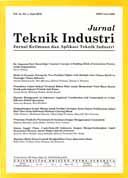System Dynamic Approach to Improve Emergency Response in Humanitarian Logistics in Indonesia
 :
:
https://doi.org/10.9744/jti.22.2.111-122
Keywords:
humanitarian logistics, replenishment, system dynamicAbstract
Volatile and vulnerable conditions during disaster relief cause many problems on the coordination of aid replenishments. Research states that partnership improves coordination thus reducing the uncertainty condition along supply chain including in replenishment. This paper aims to fulfill the research gap on examining the impact of partnership in the disaster relief process. Dynamic characteristics model of this case was built by modifying the beer distribution game through Vensim PLE Plus. Model had been validated and verified with the West Java Regional Disaster Management Authority (BPPD). The simulation was run for for two types of product: repetitive demand (food package) and one-time demand (blanket). Total cost, bullwhip effect, and total distribution time for each scenario are then compared. The simulation results show that the proposed scenario, which is developed based on the usage of blockchain on the partnership system, can reduce the total distribution time for about 43% for blanket and 27% for food package. Meanwhile, the total cost for blankets can be reduced for about 29% and 13% for food packages. But on the other side, the partnership system had aggravated the bullwhip effect. Some future potential researches are also proposed in this study.
References
AL-Khazraji, H., Cole, C. and Guo, W. (2017), Dynamics analysis of a production-inventory control system with two pipelines feedback, Kybernetes, 46 (10), pp. 1632-1653.
Akhlaghinia, N., Ghatari, A.R., Moghbel A., Yazdian A. (2018), Developing a System Dynamic Model for Pharmacy Industry. International Journal of Industrial Engineering & Management Systems, 17 (4), pp. 662-668.
Angulo, A., Nachtmann, H. and Waller, M.A. (2004). Supply chain information sharing in a vendor managed inventory partnership, Journal of Business Logistics, 25 (1), pp. 101-20.
Arminas, D. (2005). Supply Lessons of Tsunami Aid. Supply Management, 10 (2), pp. 14.
Ariningsih, P.K. and Sundara, G.Y. (2019). Blockchain for Improvement of Emergency Response in Humanitarian Logistics Indonesia. 9th Operations and Supply Chain Management Conference, Ho Chi Minh City, December 2019.
Ariningsih, P.K., Tan, A., Susanto, S. (2018). Aid Replenishment Strategy during Demand Increment On Humanitarian Logistic Relief. International Journal of Simulation: System, Science & Technology, 19 (1).
Beamon, B.M. & Balcik, B. (2008). Performance Measurement in Humanitarian Relief Chains. International Journal of Public Sector Management, 21 (1), pp. 4-25.
Besiou, M., Stapleton, O., Van Wassenhove, L. N. (2011). System Dynamics for Humanitarian Operations, Journal of Humanitarian Logistics and Supply Chain Management, 1 (1), pp. 78- 103.
Bimantio, M.P. (2019). System Dynamic Simulation of Salacca-Pondoh’s Business as Usual Condition in Sleman District, Yogyakarta Province, Indonesia. International Journal of Teknik Industri, 21 (1), pp. 25-32.
Comes, T. & Walle, B. (2016). Information Systems for Humanitarian Logistics. In H. Ira, K. Gyöngyi & S. Karen (Eds.), Supply Chain Management for Humanitarians, pp. 182-188.
Cooke, D., Rohleder, T. and Rogers, P. (2010), A dynamic model of the systemic causes for patient treatment delays in emergency departments, Journal of Modelling in Management, 5 (3), pp. 287-301.
Habib, M. S., Lee, Y. H., & Memon, M. S. (2015). Mathematical Models in Humanitarian Supply Chain Management: A Systematic Literature Review. Department of Industrial and Management Engineering, Hanyang University, Republic of Korea.
Heaslip, G. (2016). Case Study Partnerships - Supply Chain Strategy. In H. Ira, K. Gyöngyi & S. Karen (Eds.), Supply Chain Management for Humanitarians, pp. 89-99.
Hogarth Scott, S. (1999). Retailer supplier partnerships: hostages to fortune or the way forward for the millennium, British Food Journal, 101(9), pp. 668-682.
Iakovou, E., Vlachos D., Keramydas C., & Partsch, D. (2014). Dual Sourcing for Mitigating Humanitarian Supply Chain Disruptions, Journal of Humanitarian Logistics and Supply Chain Management, 4 (2), pp. 245 – 264.
Kim, D. H. (1994). System Thinking Tools: A User’s Reference Guide. Pegasus Communication, Inc.
Letcherberg, S., Widera, A., Hellingrath, B. (2017) Assessing Vendor Managed Inventory for Humanitarian Organizations, 14th International Conference on Information Systems for Crisis Response and Management, At Albi, France.
Lodree, E. (2011), Pre‐storm emergency supplies inventory planning, Journal of Humanitarian Logistics and Supply Chain Management, 1 (1), pp. 50-77.
Nakasumi, M. (2017). Information Sharing for Supply Chain Management based on Block Chain Technology. Faculty of Economics, Komazawa University. Tokyo.
Senge, P.M. (1994), The Fifth Discipline: The Art and Practice of the Learning Organization, Doubleday, New York, NY.
Sterman, J. (2000). Business Dynamics: Systems Thinking and Modelling for a Complex World, New York: McGraw-Hill.
Thomas, A. & Kopczak, L.R. (2005). From Logistics to Supply Chain Management: The Path Forward in the Humanitarian Sector, Fritz Institute, San Francisco, CA.
Tomasini R.,M. (2016). Partnerships and Innovative Procurement as Enablers for Sustainable Development Goals. In H. Ira, K. Gyöngyi & S. Karen (Eds.), Supply Chain Management for Humanitarians pp. 182-188.
Waller, M.A., Johnson, M.E. and Davis, T. (1999), Vendor-managed inventory in the retail supply chain, Journal of Business Logistics, 20 (1), pp. 183-203.
Yuliawati, E., Hadiwardoyo, S.P., Susantono, B., Tjahjono, T., 2015. System Dynamics Model for Airport Characterization in Hub-and-Spoke Networks. International Journal of Technology. Volume 6(5), pp. 733-742
Zakery, A., Afrazeh, A. and Dumay, J. (2017), Analysing and improving the strategic alignment of firms’ resource dynamics, Journal of Intellectual Capital, 18 (1), pp. 217-240.
Zhao, R., Mashruwala, R., Pandit, S. and Balakrishnan, J. (2019), Supply chain relational capital and the bullwhip effect: An empirical analysis using financial disclosures, International Journal of Operations & Production Management, 39 (5), pp. 658-689.
Downloads
Published
How to Cite
Issue
Section
License
Articles published in the Jurnal Teknik Industri: Jurnal Keilmuan dan Aplikasi Teknik Industri will be Open-Access articles distributed under the terms and conditions of the Creative Commons Attribution License (CC BY).
![]()
This work is licensed under a Creative Commons Attribution License (CC BY).



















